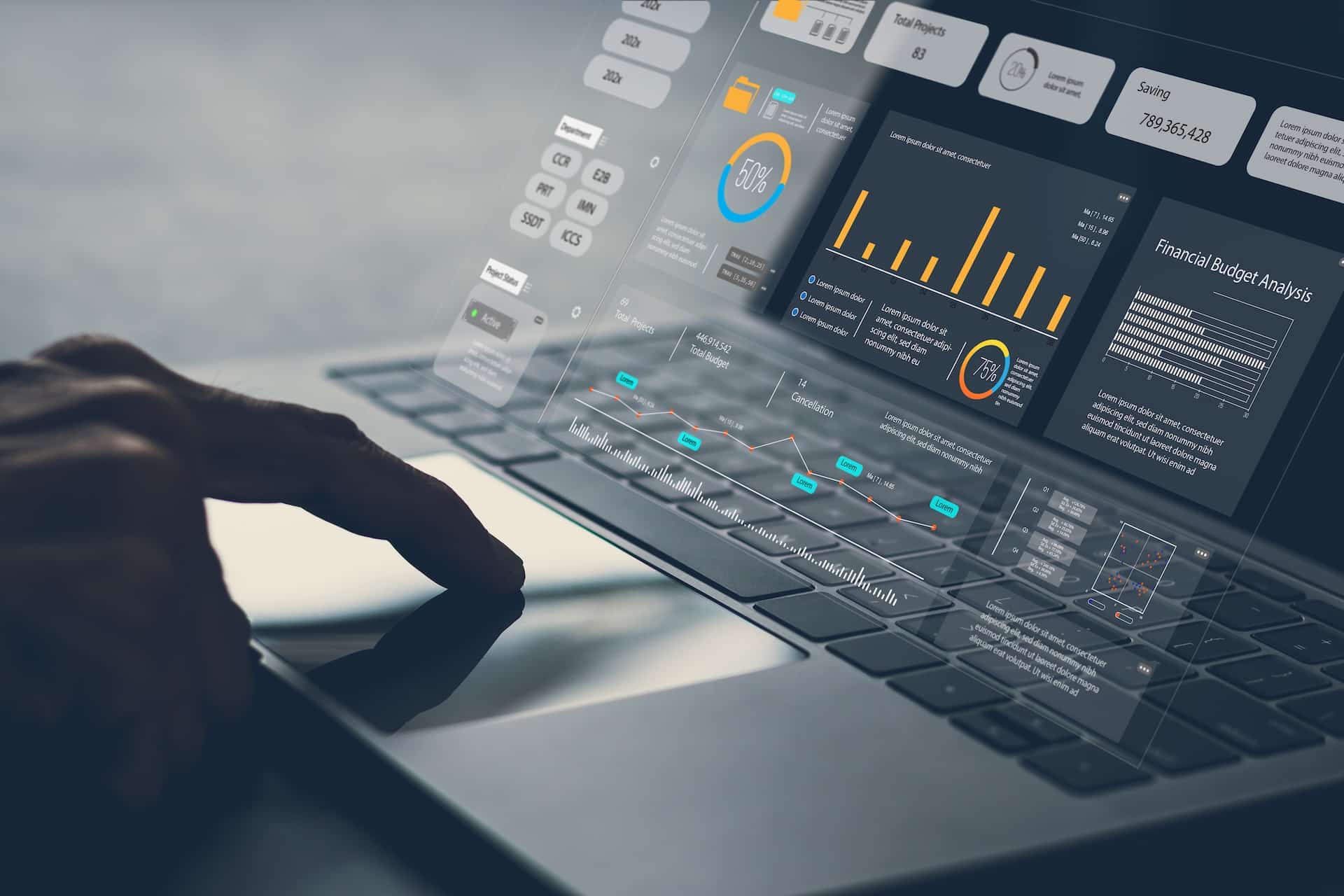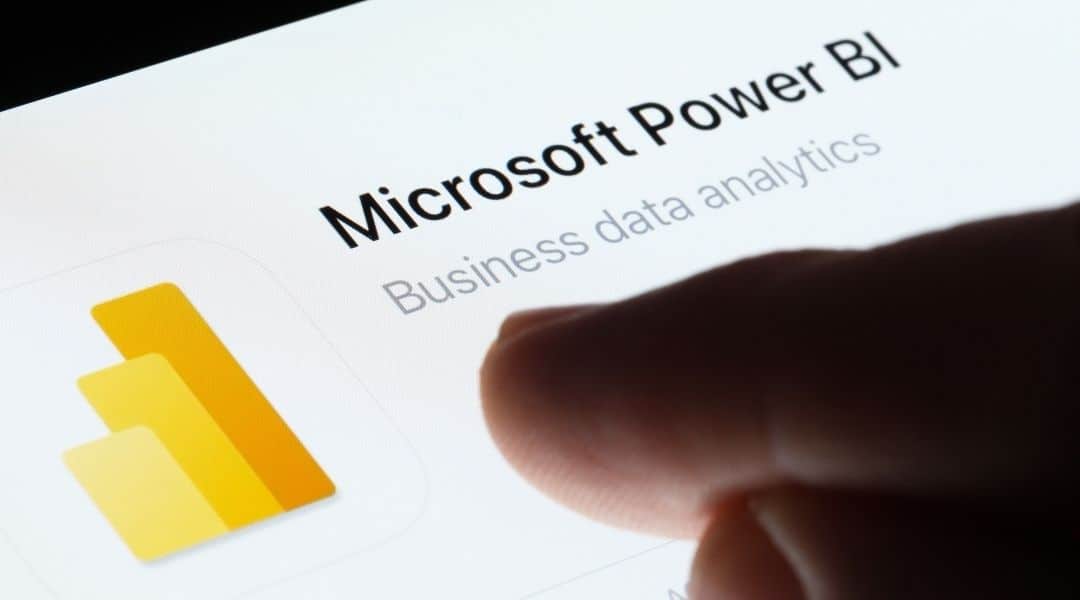What is a Power BI Dashboard?
Définition
A Power BI Dashboard is a digital dashboard that allows you to visualise data in the form of graphs, maps, tables or gauges, to name just the main ones, and also to track key performance indicators (KPIs). Unlike a simple Power BI report, the dashboard is designed to help users – even those lacking advanced technical knowledge – to understand complex data at a glance. It provides an overview of critical information in real time. A dashboard is made up of several tiles, representing visuals taken from a variety of data sets.
These dashboards are created using Power BI, a tool developed by Microsoft as part of its Business Intelligence software suite.
Why is it useful?
The amount of data to which companies are exposed these days is growing exponentially, whether it’s their own or third-party data: there is a real need to be able to use it securely. Given the multiplicity of sources of information, it is increasingly difficult to exploit the data correctly and derive a real benefit from it. This is where Power BI comes in. Here are just a few of the benefits:
- Centralising data: the data held by companies is often scattered (Excel, CRM, ERP, etc.). Power BI makes it possible to group it together in a single dashboard, clean it up and then present it in a clear and interactive way.
- Simplified visualisation: even without technical skills, it is easy to understand an indicator and how it can change, thanks to the clear, dynamic visuals.
- Faster decision-making: the ability to analyse information quickly and potentially identify discrepancies or detect a trend.
- Automatic updates: Power BI can update data at regular intervals. There’s no longer any need to do it manually.
The .pbix file is used to create reports in Power BI Desktop. The dashboards are then published on the online Power BI Service to make them accessible to other users.
| Version | Price (indicative) | Target users |
|---|---|---|
| Power BI Desktop | Free | Report creators, local individual use |
| Power BI Pro | 12.50 CHF/month/user | Sharing, collaboration and cloud publishing |
| Power BI Premium | 21.50 CHF/month/user | Advanced functions, paginated reports, AI |
| Power BI Premium (Embedded) | On quotation | Large companies, large volumes, wide deployment |
Please note: Sharing reports requires at least a Power BI Pro licence on both sides (creator and reader).
Key features of a Power BI Dashboard
Power BI incorporates a number of features that make it a comprehensive data visualisation and management tool, designed to meet the needs of data analysts and decision-makers alike.
Interactive data visualisation
Power BI offers a wide range of visualisations that enable data to be filtered and explored with just a few clicks, facilitating in-depth analysis – even for non-specialists. Users can click on part of a graph and automatically see all the other visualisations adjust to that selection.
Interactions are managed automatically via relationships defined in the data model. Users can customise the visuals using the formatting panel, or import visuals in .pbiviz format.
Connection to different data sources
One of the great strengths of Power BI is its ability to connect to a multitude of sources: Excel files, SQL databases, cloud platforms (Azure, Salesforce, Google Analytics, etc.), web APIs and many others. This flexibility makes it possible to incorporate all of an organisation’s data, even if it is scattered across several systems.
Power BI offers two ways of connecting to data sources, each adapted to meet specific needs:
Import mode
- Data is imported and stored locally in Power BI.
- Ideal for optimum performance during analysis.
- Requires regular updates to keep data up to date.
DirectQuery mode
- Data is not stored in Power BI.
- It is queried in real time with each interaction.
- Perfect for accessing data that is always up to date, but may affect performance, depending on the source.
Did you know you can integrate a Power BI dashboard into Power Apps or use Power Apps data within Power BI? See how to do it here.
Real-time updates and interactivity
Thanks to Data Gateways and streaming feeds, Power BI can receive updates in real time. This is particularly useful in fields where responsiveness is essential (logistics, e-commerce, industrial production, etc.). Interactivity brings the dashboard to life and enables it to react to the user’s needs.
Automatic data refreshes can be scheduled (up to 8 times a day in Pro, 48 times a day in Premium).
Sharing and collaboration (Power BI Service)
Thanks to Power BI Service (cloud version), dashboards can be shared with colleagues and integrated with Microsoft Teams or even SharePoint. You can manage authorisations, collaborate in real time and comment on reports.
Roles are defined, so as to secure access: some users can only view content, while others can modify or administer it.
How do I create a Power BI Dashboard?
Creating a dashboard might seem technically tricky, but in Power BI Desktop it’s a guided, step-by-step process.
Step 1: import and clean data
The first step is to connect Power BI to the data sources (Excel, SQL, etc.). Power Query Editor can then be used to clean and transform this data, to obtain a set that is suitable for analysis and reliable results. This can include:
- Delete duplicates and process missing values
- Filter columns
- Merge or split columns
- Convert data types
Step 2: create a structured data model
Once the data is clean, a well-designed logical data model needs to be established:
- Establish relationships between tables.
- Define measures (using DAX – Data Analysis Expressions)
- Create calculated columns
Power BI uses a star model (dimension/fact) to optimise performance.
Step 3: Add relevant visuals
You can then select the visuals that best answer your business questions. You can choose from over 30 integrated visuals (or customise them via the marketplace). Each visual must have a clear purpose and make the information easier to read.
Step 4: Add filters and interactivity
To make a dashboard interactive, you can:
- Add segments (filters by date, region, product, etc.)
- Activate interactions between visuals
- Use bookmarks to create multi-page navigation
- Create custom tooltips with detailed content
All these actions will allow users to explore the data at their own pace and with total control over their actions.
Step 5: Publish and share the dashboard
Once the report has been finalised, it can be published in Power BI Service for online sharing by following these steps:
- Click on ‘Publish’ in Power BI Desktop
- Configure automatic data updates
- Define access roles (RLS: Row-Level Security)
- Share via a link or embed the dashboard in Teams or another application
Best practices for a high-performance Power BI dashboard
Creating a dashboard is not just a question of design. You also need to think about performance, security and readability.
Tip: integration with Power Automate is available, so that you can send alerts or emails when thresholds are exceeded.
Compliance with UX/UI principles
To ensure that your site can be read quickly and easily, it is important to opt for a clear, user-friendly interface that complies with good design practice:
- Simple, legible visuals: do not overload the page (4 to 6 visuals per page maximum).
- Consistent use of colours: limit the number of colours used and use consistent colour palettes.
- Clearly named fields and headings: use explicit, comprehensible wording for fields and headings, to ensure that they are easy to understand.
- Place key indicators at the top of the screen: place KPIs above the waterline so that they are visible without having to scroll down the page.
Automated updates
Data needs to be updated automatically at a frequency appropriate to its nature (daily, hourly, real-time). This is done via data gateways and schedules in Power BI Service.
User access management
Data security is crucial. Power BI allows you to:
- Configure Row-Level Security (RLS) so that each user only sees their own data (adapted to suit the individual’s profile)
- Create user groups via Azure Active Directory
- Control authorisations (read, edit, publish)
Comparison of Power BI with other BI tools
Power BI vs Tableau
Tableau is renowned for its high-end visualisation capabilities, particularly for exploratory analysis. However, Power BI stands out for its native integration with the Microsoft ecosystem, its ease of use and its more competitive price.
| Criteria | Power BI | Tableau |
|---|---|---|
| Price | Very competitive | More expensive |
| Integration | Excellent with M365 | Less integrated with office suites |
| Modelling | Strong with DAX | Less modelling-oriented |
| Visualisation | Good, customisable | Superior graphics quality |
Power BI vs Google Data Studio
Google Data Studio is free and well integrated into the Google environment (Ads, Analytics), but remains limited. Power BI is more robust for professional BI projects.
| Criteria | Power BI | Google Data Studio |
|---|---|---|
| Features | Very comprehensive | Limited to simple needs |
| Connections | 160+ native sources | Less extensive, mainly Google |
| Price | Charges (Pro/Premium) | Free |
Power BI vs Excel
Excel is still widely used for simple dashboards, but Power BI is better suited to creating interactive dashboards, managing large volumes of data and secure sharing.
| Criteria | Power BI | Excel |
|---|---|---|
| Data volumes | Very high (VertiPaq compression) | Limited by memory |
| Collaboration | Cloud, multi-user | Files shared manually |
| Security | RLS and AAD authentication | Password protection |
Qim Info helps you manage a Power BI Dashboard
Qim Info, a consultancy specialising in Data solutions, offers comprehensive expertise in Power BI. Whether you’re at the start of your digital transformation or already a Power BI user, our consultants can help you with:
- Auditing and scoping your needs
- Designing high-performance data models
- Creating relevant and user-friendly reports and dashboards
- Security and governance
- Training your business and technical teams
- Upgrading maintenance
Thanks to its expertise with the Microsoft ecosystem and its knowledge of business issues, Qim Info can help you transform your data into a strategic advantage and a genuine performance driver. Whether you’re an SME in the structuring phase or a large group looking to industrialise its dashboards, we’ll support you with our methodical yet agile approach.




